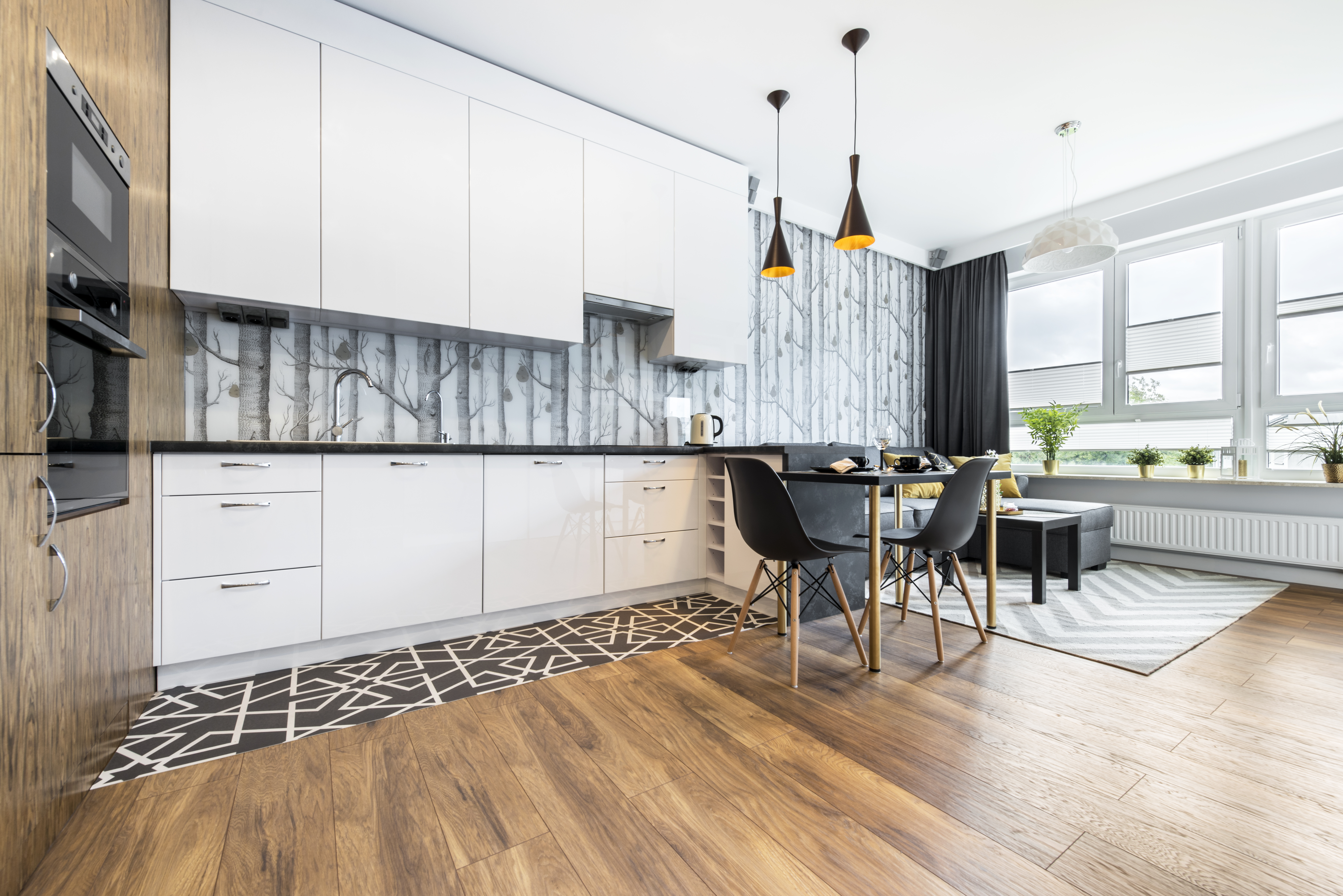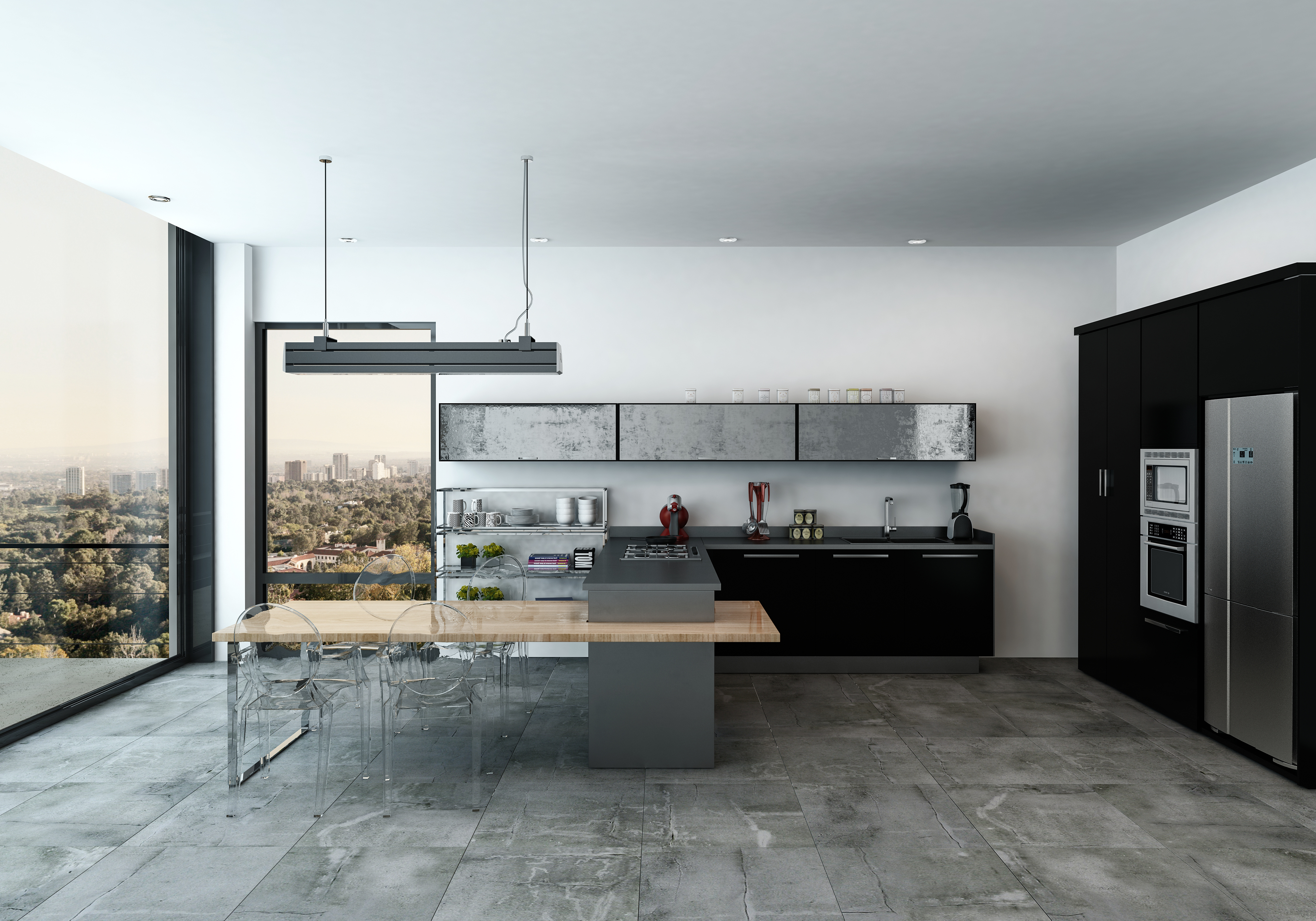
Aesthetics
- Are you after a classic look, or something more modern?
- Do you want you floor to look flawless, or would you prefer a rustic, “lived in” look?
- Is it important that you have a variety of colours, patterns and finishes to choose from?
Practicality
- Are you prepared to spend time on maintaining your floor or looking for an easy-to-clean solution?
- Does your kitchen get a lot of foot traffic and does your floor need to be particularly hardwearing?
- Is it important whether your floor has a hard finish, or has a more yielding texture? (This is especially important to consider if you have a young family, who are more likely to topple over or drop things on the floor.)
- Are you also looking to install underfloor heating? (Not all flooring options are suitable if so.)
Once you’ve identified your main considerations, you can use them to start narrowing down your options.
Let’s look at some of the most common materials used for kitchen flooring, examining their advantages and disadvantages, so you can get a better idea of which options would work best for you.
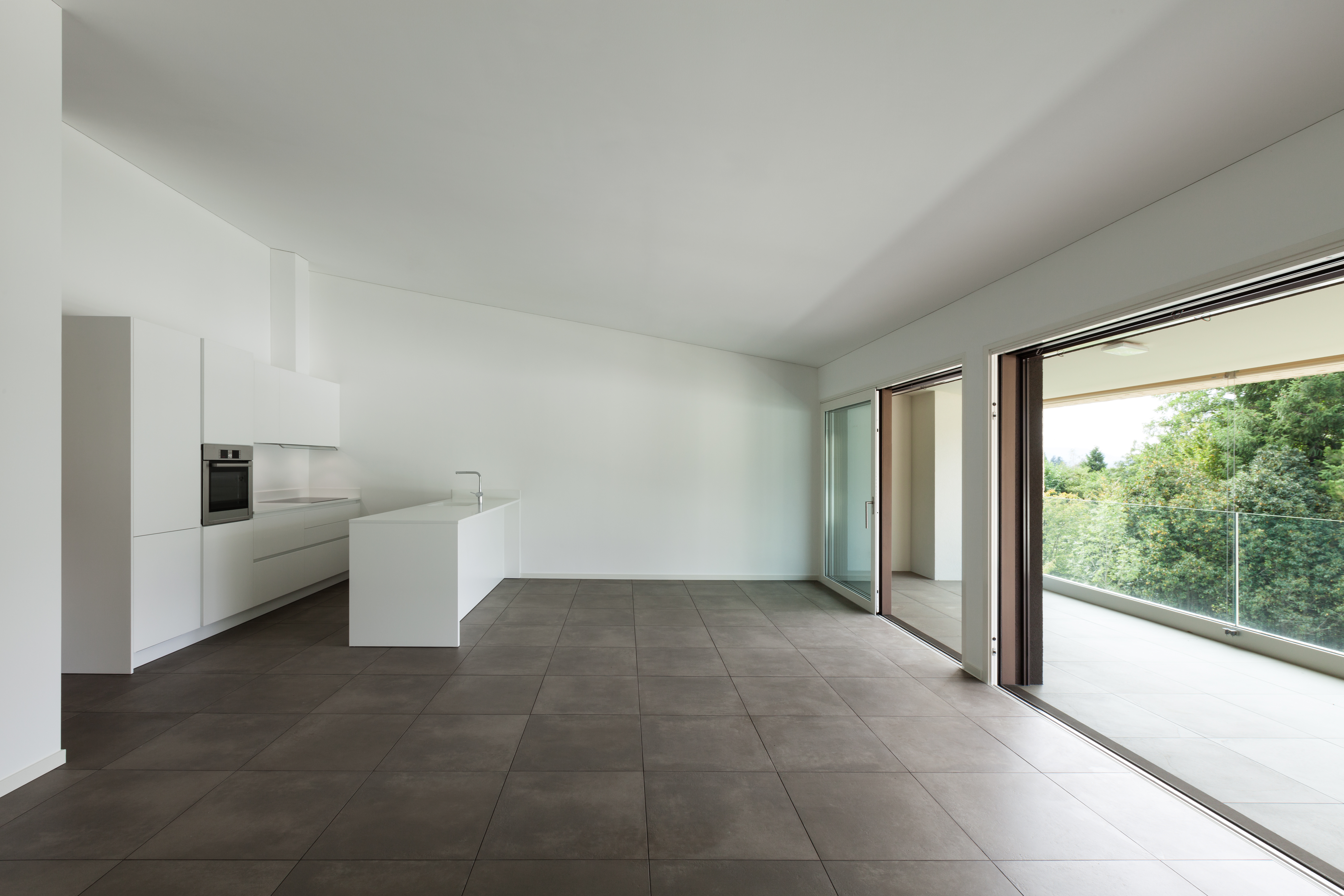
Floor Types
Linoleum
Lino floors are a relatively eco -friendly option which also have the benefit of being easy to clean. They’re available in a wide range of colours and designs so you should have no problem finding a lino floor that works with your chosen design. Other plus points include the fact that lino is relatively warm underfoot and can be laid over an existing floor.
However, it’s not easy to cut and lay so a lino floor should be done by professionals. Bear in mind that it’s also really important that it is properly sealed- otherwise it will become difficult to clean.
Can it be used with underfloor heating? Yes.
Laminate
A popular, affordable option, laminate floors are low maintenance & stain resistant, but not moisture resistant. Most commonly seen in wood -effect finishes, they are also available in slate or ceramic tile effects.
Made up of a printed high-definition image underneath a tough, transparent ‘wear’ layer, laminate floors aren’t easy to scratch. However, bear in mind that if they do get scratched, they’re not really possible to repair, so always buy an additional box of your chosen flooring so you can replace any damage or wear and tear.
Another benefit of Laminate flooring is that it’s very easy to fit. As it doesn’t involve using specialist tools, this option can save you money on hiring a professional fitter.
Can it be used with underfloor heating? Yes- with caveats. Not all laminates are suitable for electric underfloor heating, although they can all work with wet systems, so check with your provider before committing.
Porcelain or Ceramic Tiles
Porcelain and ceramic tiles are both great choices if you’re looking for a classically beautiful, easy-to-clean option for your kitchen floor.
Porcelain tiles are much more hard-wearing than most floor surfaces, therefore a luxury choice at a higher price point. Available in all shapes & sizes, smooth, textured and a range of styles & colours.
Porcelain tiles can be cold to the touch, so indoor footwear might be necessary, particularly if you spend long periods of time standing in the kitchen. Nevertheless, the surface is hardwearing to counter any wear and tear that footware or high traffic can cause. You will also need a professional to fit this option for you.
Can they be used with underfloor heating? Yes.
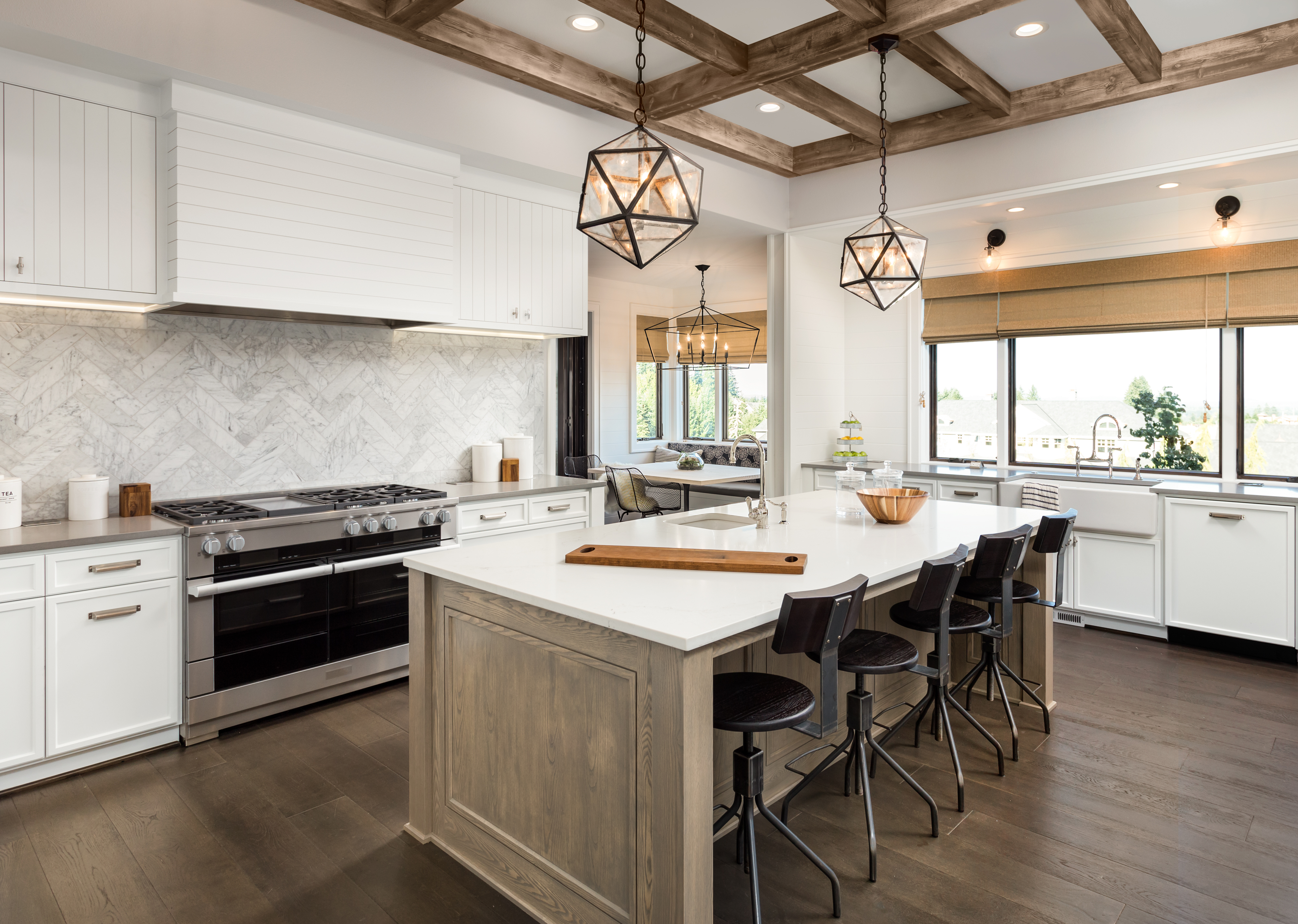
Ceramic Tiles
Just like porcelain tiles, ceramic tiles come in array of sizes, shapes, colours and textures, so make a great option as they come much more affordable than porcelain tiles. As a compromise on the cost of porcelain tiles, ceramic tiles are the most popular on the market, consequently offering a larger variation of styles & colours.
Bear in mind that unless you go for tiles with rectified edges, which are cut after being kiln fired, ceramic tiles will be unevenly shaped. This can create a fantastic, rustic look but means grout lines will be much thicker than with porcelain tiles.
Porcelain tiles & Ceramic tiles can both be textured meaning that they can both be unevenly shaped. So, I would just put this as a statement for both tile types.
Not as hardwearing as porcelain tiles, ceramic tiles are easier to chip or crack. They can also be similarly cold and unforgiving on the feet (or dropped crockery!)
Can they be used with underfloor heating? Yes.
Stone
Unsurprisingly, stone’s timeless appeal makes it an enduringly popular choice for kitchen floors. Including granite, slate and limestone, stone’s natural variations are what give it its unique beauty. Another advantage is its hardwearing nature; it’s extremely strong and long-lasting and is also easy to maintain.
The stone’s hardness means it’s another option that’s not particularly comfortable, so it may not be the best option for you if you’re likely to be spending a lot of time on your feet.
While stones’ Hardness doesn’t make for the most comfortable flooring, it can also be cold to the touch. This isn’t the best option for families that might be concerned about children or family members falling on the surface. However, the possibility of rugs compliments the surface adding further aesthetics.
It can also visibly harbour dirt if uneven and show wear, particularly if darker in colour.
Can it be used with underfloor heating? Absolutely! Stone is a great heat conductor so an ideal choice if you’re looking to install underfloor heating.
Wood
Wood floors come in either solid or engineered form.
Solid wood
Solid wood is particularly forgiving on the feet as it’s warm to the touch and has some give. Beautiful to look at, as well as robust and long lasting, it has incredible versatility and can be sanded or dyed to create a look to suit your space.
Solid wood floors can be expensive to install as their tendency to move means they need to be installed with a subfloor. They can also be noisy so aren’t the best option if you live in a flat, (at least for your neighbours!) and can easily stain or scratch. Solid wood floors are a natural product can fade over time, these are characteristics of a Natural product.
Can it be used with underfloor heating? No.
Engineered wood
Seen by many as the perfect compromise between solid wood and laminate flooring, engineered wood boards are made up of two sheets of wood veneer, placed either side of a layer of birch ply. They look very similar to solid wood but are more stable and don’t expand or contract.
It’s available in either lacquered or raw form, so can be matched with a wide range of kitchen styles, from chic and modern, to rustic. However, bear in mind that the finish you opt for also impacts the material’s functionality; lacquered options are sealed so more hardwearing, whereas raw options have the same tendency to scratch and stain as solid wood boards.
Can it be used with underfloor heating? Yes.
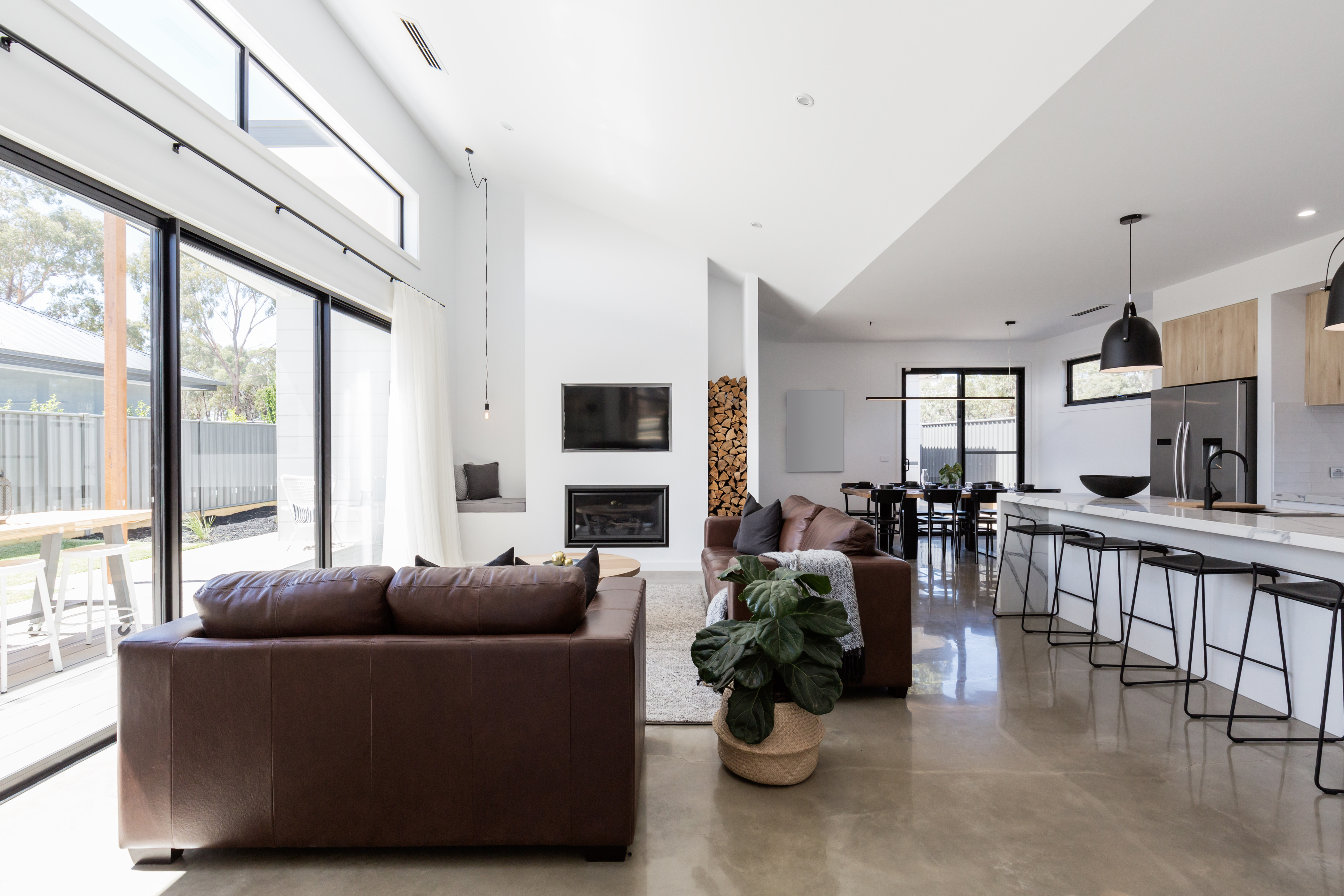
Other materials
Now we’ve looked at the main types of kitchen flooring available, let’s take a look at some of the less well-known options. Have you considered opting for cork, rubber, poured resin, vinyl or polished concrete?
Cork
Did you know that removing the bark from cork trees actually helps them to live longer? Cork is a great, eco-friendly option for kitchen floors, and that’s far from its only plus point. It’s warm, forgiving on the feet, easy to clean and naturally antibacterial, so a great all-round practical option for kitchen floors.
Cork also gives lots of choice in terms of aesthetics; not only available in the traditional, exposed finish, it can also be coated with vinyl, giving a wide choice of finishes.
Because of its soft nature, there is a risk that heavy furniture will leave a dent in it. It’s also not as scratch resistant as some of the other options and can fade in strong sunlight.
Can it be used with underfloor heating? Some types- check with your provider before making a commitment.
Rubber
Similar to cork, rubber is a warm and forgiving option for a kitchen floor, although it can be slippery. It’s non-porous so resistant to stains- a great choice if you’re a messy cook!
Again, because it’s soft and yielding – great for the feet! – there is a risk that heavy furniture will leave divots and its colour also has the tendency to fade in strong sunlight.
Can it be used with underfloor heating? Rubber flooring can take some underfloor heating but isn’t suitable for use with very high temperatures. Check with your supplier for further information on guidelines.
Vinyl
If you’re looking to make the most of your budget, vinyl is a great choice. It comes in a range of colours and patterns and is very easy to clean. Not as hardwearing as some other options, it does have a relatively short life span, and, again, its colour may fade in strong sunlight.
Vinyl flooring is packages as a roll and can be fit using non- specialist tools, which means you can save money by fitting it yourself.
Can it be used with underfloor heating? Similar to rubber, vinyl flooring can take some underfloor heating but isn’t suitable for use with very high temperatures. Check with your supplier for further information on guidelines.
Poured resin
Hypoallergenic, waterproof, resilient, warm and easy to clean, resin’s plus points are many! An ideal choice for a modern kitchen, it can be poured over the entire kitchen floor to create a sleek, seamless finish and comes in either a matte or gloss finish.
Bear in mind that it can stain if spills aren’t wiped up quickly and that gloss finishes tend to show up marks.
Can it be used with underfloor heating? Yes.
Polished Concrete
If it’s an edgy look you’re going for, consider making polished concrete your material of choice. It’s also hardwearing, easy to clean and had outstanding thermal qualities.
It’s another very hard option, so not particularly forgiving. If you have young children who are still unsteady on their feet (or older ones who are accident prone!), it may not be the most family-friendly option for you.
Can it be used with underfloor heating? Yes.

